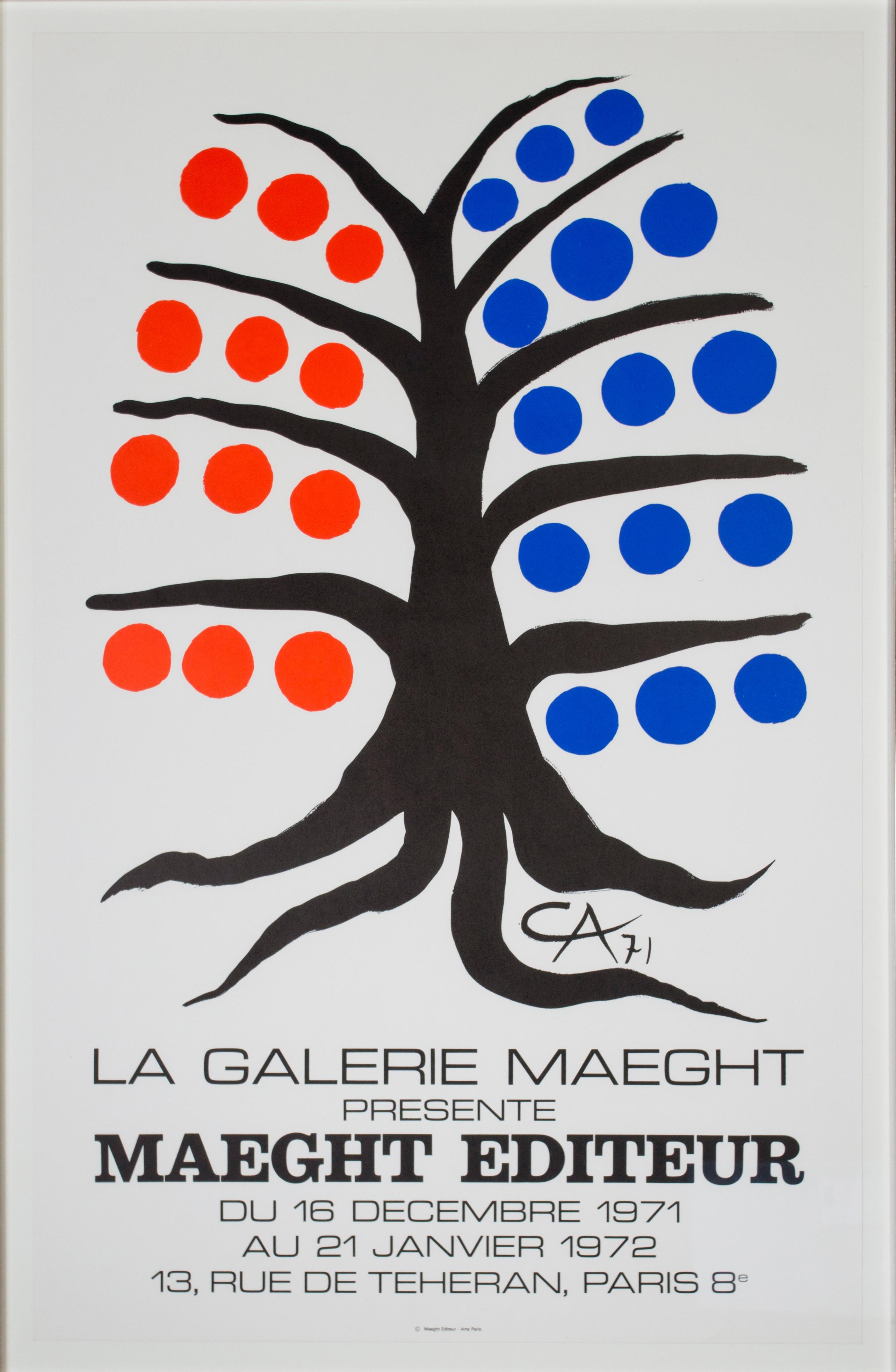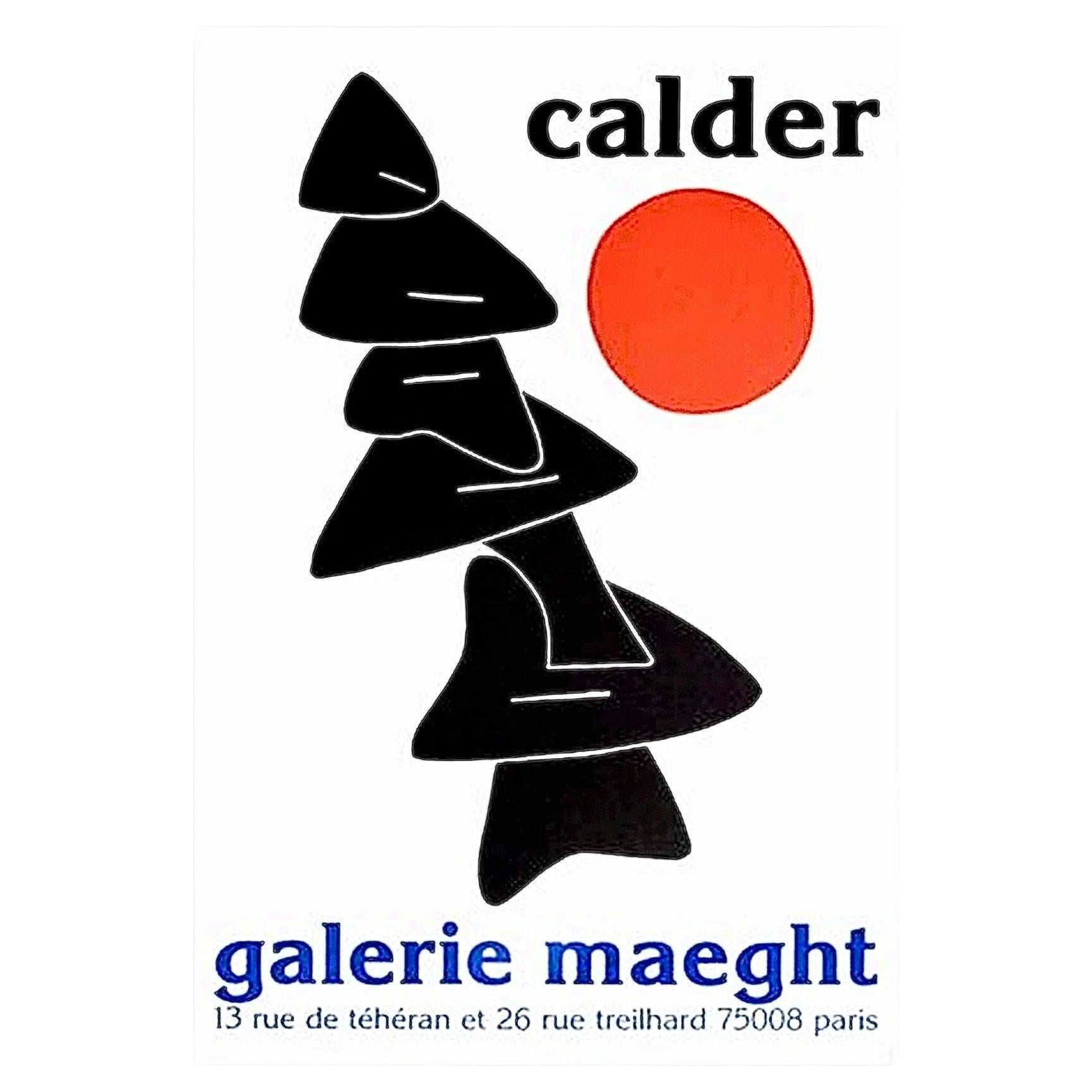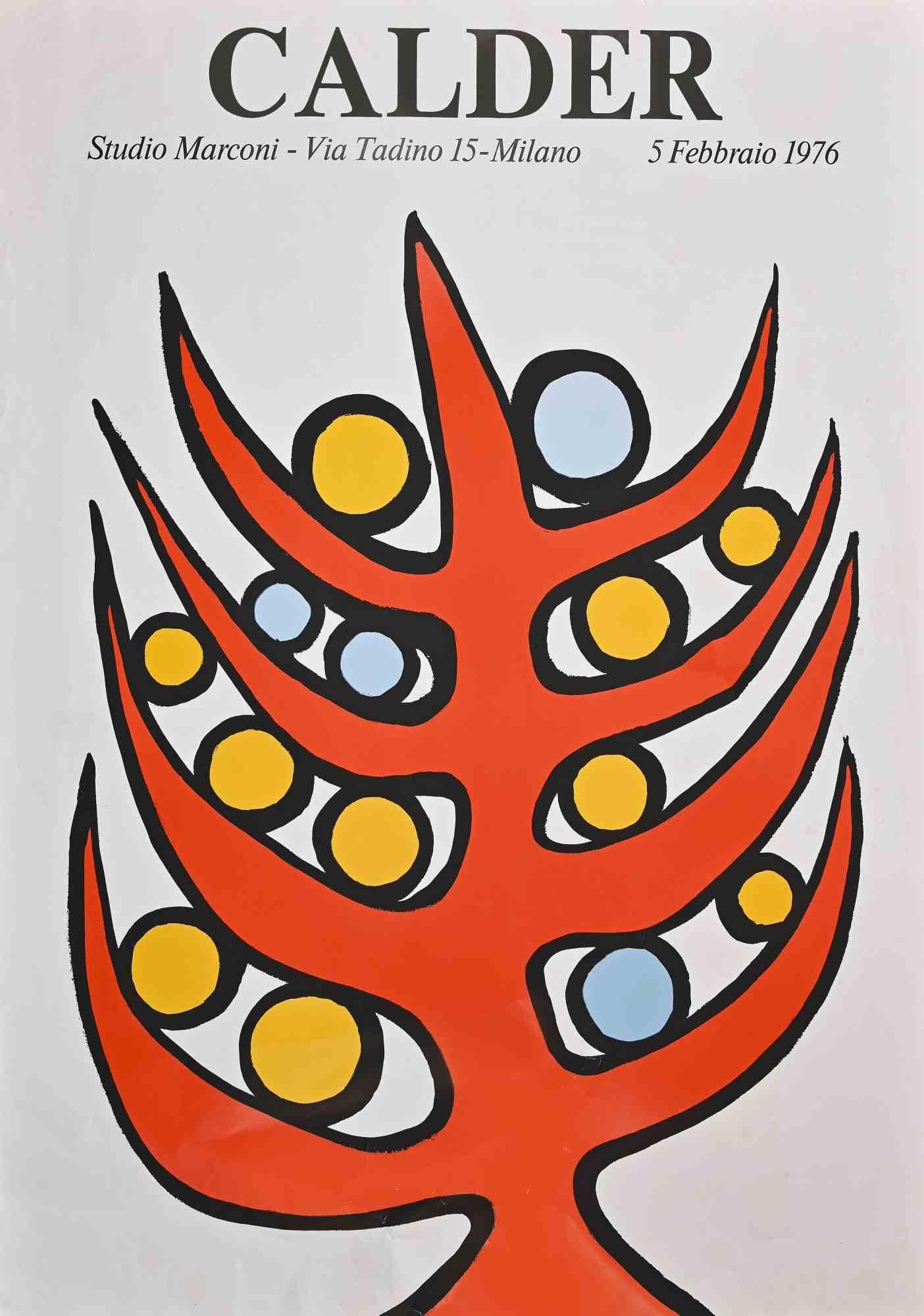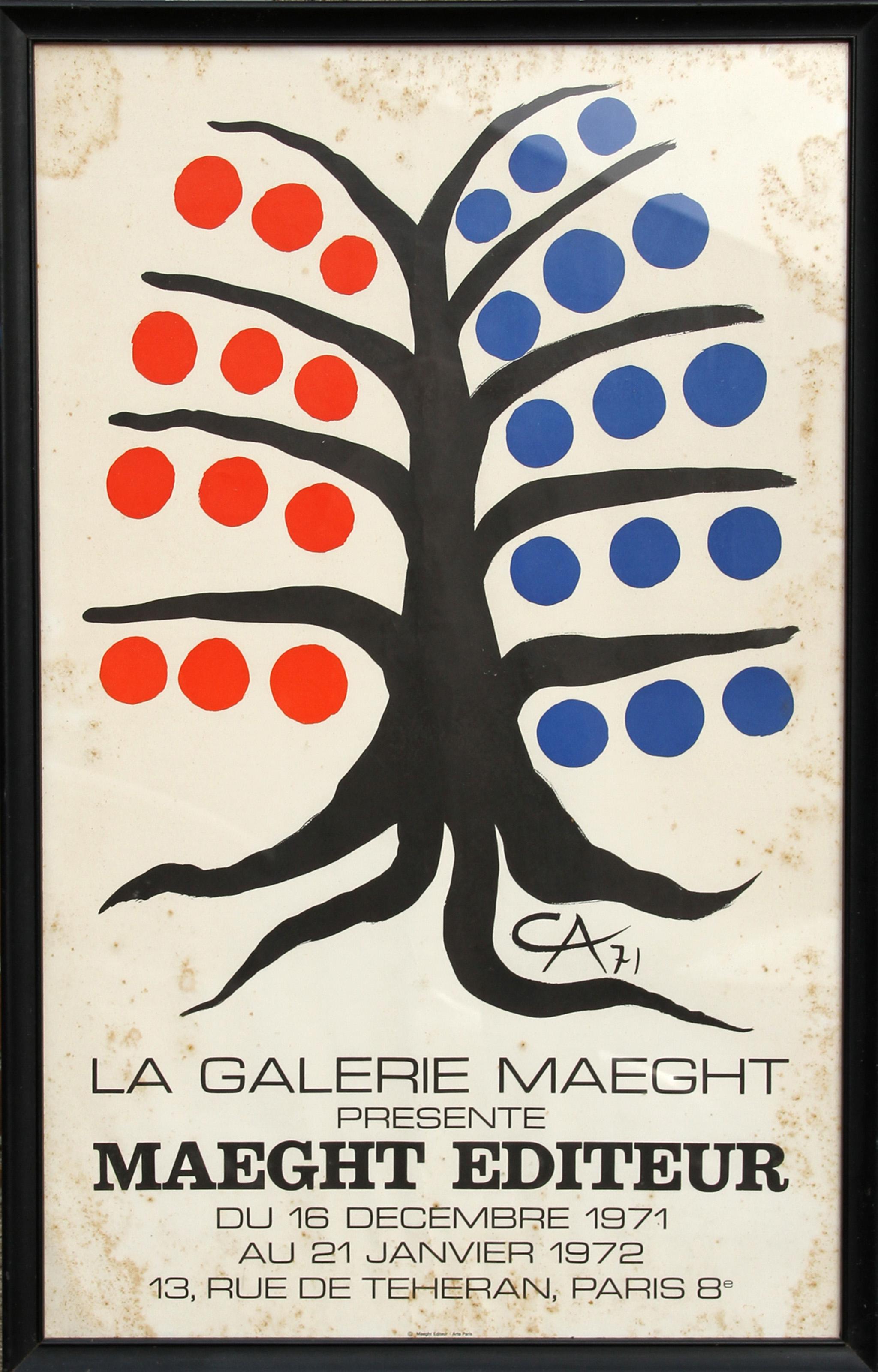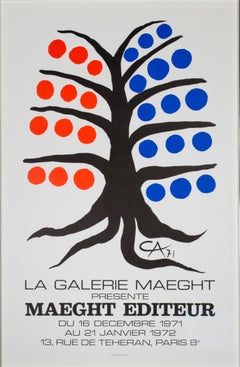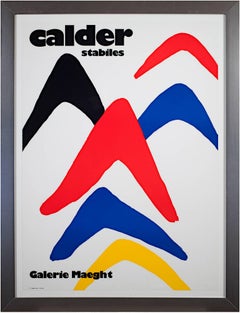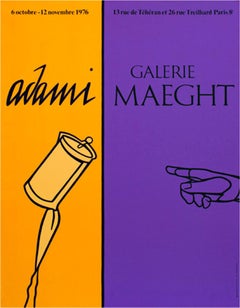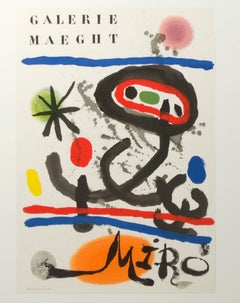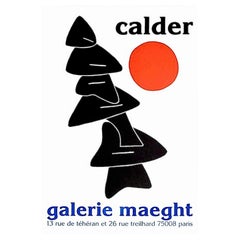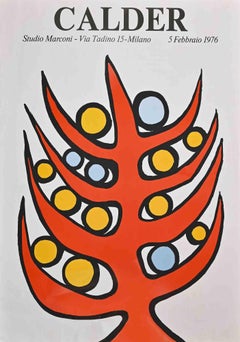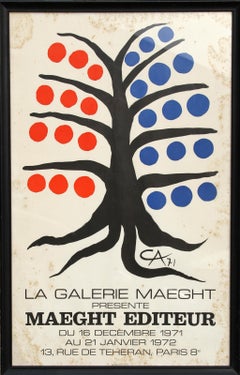Items Similar to "Stabile with Red Sun Galerie Maeght" Lithograph Poster
Want more images or videos?
Request additional images or videos from the seller
1 of 8
"Stabile with Red Sun Galerie Maeght" Lithograph Poster1976
1976
$3,240
£2,522.49
€2,868.49
CA$4,658.20
A$5,115.61
CHF 2,671.46
MX$61,056.88
NOK 33,844.90
SEK 31,544.78
DKK 21,423.86
About the Item
"Stabile with Red Sun Galerie Maught" is a color lithograph poster. The Stabile is a black topsy-turvy statue taking up most of the piece. A red sun sits to the right of the black stabile. Unsigned.
Art: 29 x 19 in
Frame: 33 x 22.37 in
American sculptor and painter, born at Lawnton, a suburb of Philadelphia. His grandfather, Alexander Milne Calder, and his father, Alexander Stirling Calder. were sculptors and his mother was a painter. His father had charge of the sculptural work for the Los Angeles World Exhibition in 1912. Alexander Calder, however, studied mechanical engineering from 1915 to 1919 and began to take an interest in landscape painting only in 1922 after having tried his hand at a variety of jobs. In 1923 he enrolled at the School of the Art Students' League. New York, where George LUKS and John SLOAN were among the teachers. Calder and his fellow students made a game of rapidly sketching people in the streets and the underground and Calder was noted for his skill in conveying a sense of movement by a single unbroken line. He also took an interest in sport and circus events and contributed drawings to the satirical National Police Gazette. From these activities it was but a step to his wire sculptures, the first of which -- a sun-dial in the form of a cock -- was done in 1925. In 1927 he made moving toys for the Gould Manufacturing Company and small figures of animals and clowns with which he gave circus performances in his studio. His first exhibition of paintings was in the Artists' Gal.. New York, in 1926; his first Paris one-man show was in the Gal. Billiet in 1929 and the Foreword to the catalogue was written by PASCIN. whom he had met the previous year. His wire figures were exhibited by Carl Zigrosser at the Weyhe Gal. and Bookshop, New York, in 1928 and at the Neumann and Nierendorf Gal., Berlin, in 1929, when they were made the subject of a short film by Dr. Hans Curlis. During the 1930s Calder became known both in Paris and in America for his wire sculpture and portraits, his abstract constructions and his drawings. In 1931 he joined the ABSTRACTION-CREATION association and in the same year produced his first non-figurative moving construction. The construetions which were moved by hand or by motor power were baptized 'mobiles' in 1932 by Marcel DUCHAMP and ARP suggested 'stabiles' for the non-moving constructions in the same year. It was in 1934 that Calder began to make the unpowered mobiles for which he is most widely known. Constructed usually from pieces of shaped and painted tin suspended on thin wires or cords, these responded by their own weight to the faintest air currents and were designed to take advantage of effects of changing light created by the movements. Thev were described by Calder as 'four-dimensional drawings'. and in a letter to Duchamp written in 1932 he spoke of his desire to make 'moving Itlondrians'. Calder was in fact greatly impressed by a visit to Mondrian in 1930 and no doubt envisaged himself as bringing movement to Mondrian-type geometrical abstracts. Yet the personality and outlook of the two men were very different. Calder`s pawky delight in the comic and fantastic, which obtrudes even in his large works, was at the opposite pole from the Messianic seriousness of Mondrian. Calder continued to do both mobiles and stabiles until the 1970s, sometimes combining the two into one structure. Some of these works were of very large dimensions: Teodelapio (1962), a stabile for the city of Spoleto, was 18 m high and 14 m long; Man, done for the Montreal World Exhibition of 1967, was 23 m high; Red Sun (1967) for the Olympic Stadium, Mexico, was 24 m high and the motorized hanging mobile Red. Black and Blue (1967) at Dallas airport was 14 m wide. His interest in animal figures and the circus also continued into the 1970s and in 1971 he was making 'Animobiles' reminiscent of animals. Although he had done gouaches since the late 1920s, he began to take a more serious interest in them and to exhibit them from 1952.
- Creation Year:1976
- Dimensions:Height: 33 in (83.82 cm)Width: 22.37 in (56.82 cm)
- Medium:
- Movement & Style:
- After:Alexander Calder (1898 - 1976, American)
- Period:
- Condition:
- Gallery Location:Milwaukee, WI
- Reference Number:Seller: 511d1stDibs: LU60535524752
About the Seller
4.9
Gold Seller
Premium sellers maintaining a 4.3+ rating and 24-hour response times
Established in 1966
1stDibs seller since 2017
452 sales on 1stDibs
Typical response time: 1 hour
- ShippingRetrieving quote...Shipping from: Milwaukee, WI
- Return Policy
More From This Seller
View All"Maeght Editeur, " Original Color Lithograph Poster
By Alexander Calder
Located in Milwaukee, WI
"Maeght Editeur" is a color lithograph poster. This poster was for an exhibit on Alexander Calder's work in Paris, France. It depicts a black tree with red fruits on the left side an...
Category
1970s Post-Modern Landscape Prints
Materials
Lithograph
'Stabiles' original lithograph poster after Alexander Calder, Galerie Maeght
By Alexander Calder
Located in Milwaukee, WI
'Stabiles' is a lithograph poster after Alexander Calder and published by Galerie Maeght in 1971. Calder had produced the stones for this lithograph a year earlier in 1970 for a prin...
Category
1970s Abstract Expressionist Abstract Prints
Materials
Lithograph
"Galerie Maeght, " an Original Color Lithograph Poster by Valerio Adami
By Valerio Adami
Located in Milwaukee, WI
"Galerie Maeght" is an Original Lithograph Poster bu Valerio Adami. This poster was created to advertise Adami's show at the Galerie Maeght in 1976. The print is orange on the left s...
Category
1970s Expressionist More Prints
Materials
Lithograph
Abstract color lithograph 20th century poster
By Joan Miró
Located in Milwaukee, WI
"Galerie Maeght Miro" is an original color lithograph poster with art by Joan Miro. It was printed by Maeght Editeur Imprimeur in 1970. The poster showcase...
Category
1970s Surrealist Abstract Prints
Materials
Lithograph
Lithographie Originale IV, from Miro Lithographs IV, Maeght Publisher Joan Miró
By Joan Miró
Located in Milwaukee, WI
"Lithographie Originale IV" is an original color lithograph by Joan Miro, published in "Miro Lithographs IV, Maeght Publisher" in 1981. It depicts Miro's signature biomorphic abstrac...
Category
1980s Abstract Abstract Prints
Materials
Lithograph
"Derriere Le Miroir" Catalog with Five Lithographs
By Alexander Calder
Located in Milwaukee, WI
"Derriere Le Miroir" is a portfolio of lithographs by Alexander Calder. The artist signed the portfolio on the last page. This is edition number 146/150 of the deluxe edition, with t...
Category
1970s Modern Abstract Prints
Materials
Lithograph
You May Also Like
Stabiles - Lithograph poster (Maeght)
By Alexander Calder
Located in Paris, IDF
Alexander Calder
Stabiles
Lithograph poster
Made for the exhibition of Alexander Calder at Maeght Gallery
Printer: Arte Paris
Editor: Maeght
77 x 55 cm (c. 30.3 x 21.6 in)
Excellen...
Category
1970s Abstract Geometric Abstract Prints
Materials
Lithograph
1976 Alexander Calder Exhibition Poster Stabile Noir Et Soleil Rouge
By Alexander Calder
Located in St.Petersburg, FL
1976 Alexander Calder Exhibition Poster Stabile Noir Et Soleil Rouge
Bold, dynamic, Alexander Calder exhibition lithograph poster produced by Galerie Maeght for the winter show at t...
Category
Vintage 1970s Danish Mid-Century Modern Prints
Materials
Paper
Calder Exhibition Poster - Vintage Screen Print by Alexander Calder - 1976
By Alexander Calder
Located in Roma, IT
Calder Exhibition Poster is an artwork realized by Alexander Calder in 1976
Mixed colored serigraph.
Fair conditions with some tears along the margin.
This beautiful and colored p...
Category
1970s Contemporary More Prints
Materials
Screen
La Galerie Maeght presente Maeght Editeur, Lithograph Poster by Alexander Calder
By Alexander Calder
Located in Long Island City, NY
Alexander Calder, American (1898 - 1976) - La Galerie Maeght presente Maeght Editeur. Year: 1971, Medium: Lithograph Poster, Size: 31 in. x 19 in. (78.74 cm x 48.26 cm)
Category
1970s Modern Prints and Multiples
Materials
Lithograph
Black Tree with Red Sun - Lithograph poster - Maeght, 1976-77
By (after) Alexander Calder
Located in Paris, IDF
Alexander CALDER (after)
Black Tree with Red Sun, 1976-77
Lithograph poster
Made for the exhibition of Alexander Calder at Maeght Gallery in 1976-77
Printer : Arte Paris
Editor : Ma...
Category
1970s Abstract Geometric Abstract Prints
Materials
Lithograph
Calder Exhibition Poster - Vintage Screen Print after Alexander Calder - 1976
By Alexander Calder
Located in Roma, IT
Calder Exhibition Print is a screen print realized by Alexander Calder in 1976.
Good condition except for some folding and scratches.
This beautiful and colored print was realized...
Category
1970s Contemporary More Prints
Materials
Screen
More Ways To Browse
Mobile Stabile
Sun Dial
Hanging Mobile
Vintage Hanging Mobile
Robert Mazal
Robert Motherwell Roth Handle
Roland Poska
Rothko Lithograph
Roy Lichtenstein Cathedral
Roy Lichtenstein Imperfect
Ruth Sica
Ryo Tokita
Salvador Dali Lettre
Salvador Dali The Alchemist
Sam Calder
Sam Francis Swatch
Savoy Damien Hirst
Scott Kilgour
